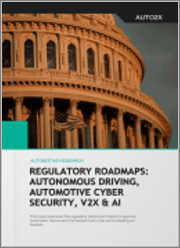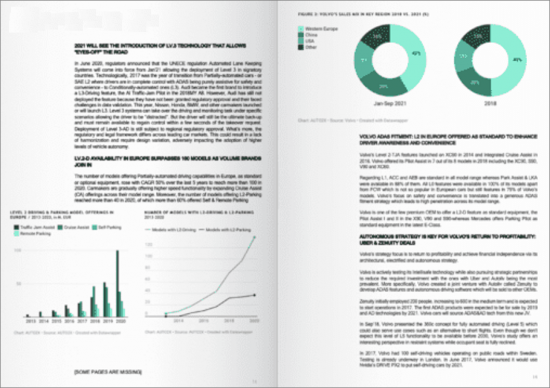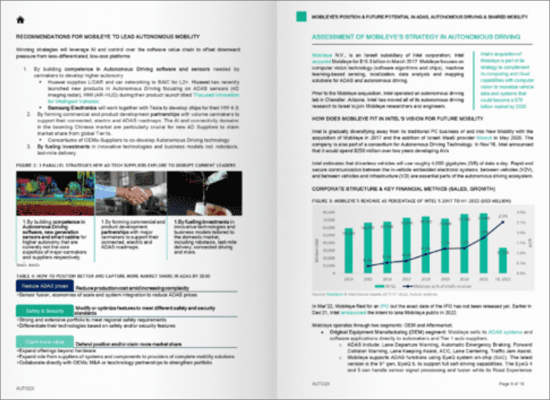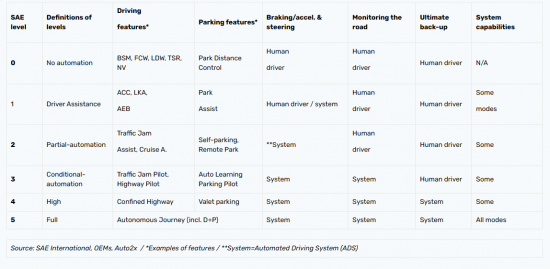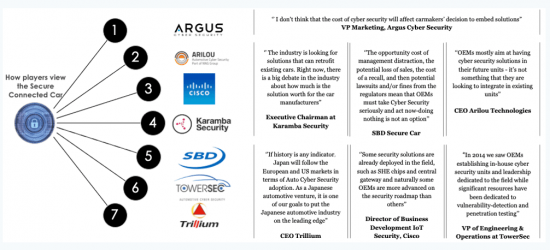Regulatory Roadmaps to Level 3 - 4 Autonomous Driving, Automotive Cyber Security, V2X & AI
이 보고서는 자동차 시장에 대한 조사 분석을 통해 감시 운전에서 조건부 및 완전 무감시 운전(SAE 레벨 3-5)으로의 전환에 대한 규제 상황과 유럽, 미국, 중국, 일본, 영국 및 기타 지역의 규제 의무화 및 정책 로드맵과 일정 등을 제공합니다.
샘플보기
목차
주요 요약
- 레벨 4 자율주행 규제가 준비중
- 독일, 로보택시와 자율주행 셔틀을 시장 진입을 위한 L4 규제를 가결
- 미국은 AV 테스트 이니셔티브 확대에 의해 AV 테스트 명확성을 강화
- UNECE 규제 개정에 의해 2021년에 레벨 3 자율주행이 마침내 허가될 전망
- 자동차 사이버 보안은 필수가 되고 있다
- ICV에 대한 중국의 대처에 의해 규제 변경이 빠르게 이루어질 수 있다
- L3 자동 모드에서 발생한 사고로 인한 보험 청구를 지원하는 데이터 스토리지
- 예방 안전 규제에 의해 ADAS 보급과 승객 모니터링이 촉진된다
제1장 SAE Lv.3·Lv.4 시스템에 대한 자율주행 규제
- 자율주행 규제 : 현재와 향후 기술과 규제와의 격차
- 규제 프로세스와 자율성을 향한 경쟁의 본질적인 차이로 인한 조화 결여에 대한 우려가 발생
- 규제는 전개에 어떠한 영향을 미치는가? L3 전개에 적합한 지역
- UNECE : UN R79 수정과 수평적 규제
- 독일이 지원적인 AD 프레임워크에 의해 유럽에서의 AD 전개를 주도
- 영국이 세계의 AD 허브로서 경쟁할 기회 : 혁신, 테스트, 전개
- 미국의 유연하면서 안전성과 조화가 우려되는 자율주행 규제 체계
- 중국의 지능형 커넥티드카(ICV) 규제
- 일본의 AD 규제 상황
- 기타 주요 시장의 AD 규제 동향 개요
제2장 ADAS L1-L2·NCAP Lv2 등급에 대한 액티브 세이프티 규제
- ADAS의 UX/UI에 의한 운전자 주의 산만, 혼란, 오용 문제
- UN GSRII가 운전자 주의력 산만에 대처하기 위한 예방 안전 장치를 의무화
- EuroNCAP의 하이웨이 어시스트 /Lv.2 기능에 대한 2020년 평가
제3장 SAE 레벨 3 조건부 자동화의 데이터 기록과 책임
- 자율주행 이벤트 데이터 레코더가 필요한 이유를 배운다
- L3 데이터 기록과 보관에 관한 규제상 가이던스가 미흡하다
- L3 차량 자동화는 보험 밸류체인에 과제와 기회를 가져온다
제4장 주요 자동차 시장의 자동차 사이버 보안 규제
- 새로운 규제에 의해 자동차 사이버 보안 전개와 표준화가 촉진된다
- 미국의 자동차 사이버 보안 규제 조치
- 자동차 사이버 보안에 관한 유엔(국제) 규제 : EU·일본
- 소프트웨어 갱신과 그 관리 시스템에 관한 두 가지 새로운 유엔 규칙
- ISO/SAE 21434 : 자동차 사이버 보안을 조화시키기 위한 공동 규격
- 커넥티드카를 보호하려면 어떠한 규제/법적 조치가 필요한가?
- V2X 통신을 위한 사이버 보안
제5장 Vehicle-to-Everything V2X : V2V-V2I 규제
- V2V·V2I 통신은 교통 안전에 어떻게 도움이 되는가?
- V2V는 HAV 기술의 전제조건은 아니지만 안전성을 강화할 수 있다
- 최첨단 : V2V·V2I는 이미 오늘날 실용화되어 있다
- V2V-V2I 규제 로드맵 : 유엔·미국·중국
- DSRC 기반 V2V·V2I 보안과 프라이버시
- Autotalks CTO에 의한 V2X 규제 활동에 관한 인사이트
제6장 자동차용 AI에 관한 규제
- 유럽위원회가 "고위험" AI 애플리케이션을 규제하는 최초의 시도
- AI 윤리 규정 : BMW Group·Continental
부록 : 보고서 내 규제와 법률 개요
ksm
Regulatory Roadmaps unveil the transition to autonomous, secure and Connected Car. Read this report to learn about
- The status of the regulatory landscape for the transition from Supervised to Conditionally & Fully-Unsupervised-Driving (SAE Level 3-5).
- The mandatory features of Active Safety, regulations for V2X, and ethical AI.
- Roadmaps and timelines of regulatory mandates and policies in Europe, the USA, China, Japan, the UK and other geographies
- The impact of regulation on market competition and technology adoption
SAMPLE VIEW
The lack of a harmonized regulatory framework for Level 4-Automated Driving restricts deployment
The lack of harmonization of Autonomous Driving regulation across major car markets remains the key roadblock to the deployment of L3-4.
Carmakers and developers of autonomous driving technology face compliance regulatory requirements that are different across major car markets. For example, for countries such as Japan, China, and the EU members that are signatories of the UNECE regulation, there is no framework for type approval of Level 4.
- Germany, was one of the first countries globally to allow testing of L4 but this applies to robotaxis and autonomous shuttles, not private car ownership.
- On the other hand, the U.S follows self-certification with relevant FMVSS & voluntary guidelines for L4 testing and deployment but there is no federal regulation in place.
- In Apr'22, Japan revised its traffic rules for Level 4 autonomy with enforcement from May 2023.
SAE Lv.4-Full automation describes the scenario where drivers can completely hand over vehicle control and monitoring to the Automated Driving System for specific driving scenarios under the Operational Design Domain of the systems, e.g. Lv.4-Parking Valet parking or L4.-Driving Cruising Chauffeur.
Until today, the only vehicles allowed to operate in Lv.4 Autonomous Driving are robotaxis from Waymo and others. In private car ownership, the highest level of autonomous driving available in the market is Level 3-Conditional Automation.
Regulatory amendment in UNECE finally allowed Level 3-Autonomy in 2021 but global deployment is still fragmented
After almost 3 years in the making, the amendment of UNECE Reg. No.79-Steering Equipment will allow Level 3 in countries adopting the new rules called "Automated Lane Keeping System".
The ALKS regulation is set to apply to 60 countries including the UK, Japan, and EU member states from January 2021, to enable the safe introduction of 'Level 3' automation features in certain traffic environments.
UN regulations manage pre-sale Type Approval, i.e. the Regulation sets out clear performance-based requirements that must be met by car manufacturers before ALKS-equipped vehicles can be sold within countries mandating the Regulation.
"UNECE's Automated Lane Keeping System regulation is applicable for LEVEL 3, for low-speed (60 km/h) highway-only"
We see Europe and Japan benefiting from the changes in regulation due to the combination of technological capabilities in Level 3 from their domestic carmakers and the favorable political framework to remove roadblocks and establish their respective markets as key innovation hubs.
What are the key challenges in the amendment of regulatory requirements for higher levels of Autonomous Driving?
- As automotive and technology players race to develop and deploy higher vehicle autonomy to unlock enhanced safety in passenger cars and commercial vehicles, new revenues (pricing models of Lv.4, AMoD) and USPs, the slow amendment progress of regulation and the lack of harmonization create barriers for their commercialisation strategies
- Regulation needs to transition from driver-centric to Automated Driving Systems (ADS) to allow today's Supervised driving (SAE Level 0-2) to shift to Conditionally (SAE Lv3) & Completely-Unsupervised driving; (Lv.4-5). But lack of regulatory standardization across major car markets will create regional hubs (aka "islands", such as cities where technology is allowed) and require design variation from OEMs
- The vehicle automation mix is changing with the proliferation of Lv2 driving features. In 2020, Euro NCAP released the ratings of 10 Lv.2 / Highway Assist systems marking Audi's Q8, BMW 3, and GLE "Very Good".
- With the introduction of Lv.3 allowing Conditionally-Unsupervised driving and vehicles with different levels of autonomy co-existing on the road, clear safety requirements are needed in the form of standardized, international AD regulation which could mitigate scepticism of higher vehicle autonomy.
The transition from driver-centric regulation to Automated Driving Systems will allow the shift from Supervised driving to Conditionally (Lv3) & Completely-Unsupervised driving
Admissibility of automated driving functions depends on the driving and monitoring tasks, i.e. driver engagement, which can be derived by (or inferred by) the level of vehicle automation (SAE J3016 or BASt).
2016-17 saw a shift in the focus of regulation from approving pilots and testing of technologies falling under SAE Level 3/4 to discussion for amendments or event action to enable deployment of Level 3 on public roads. The most evident example was the amendment of the German Road Traffic Act which allows Level 3 from Sep'17, once these systems are type-approved by UNECE regulations.
Meanwhile, the amendment of Regulation No.79 has progressed in Europe to approve Level 3 features under ALKS.
Finally, the world's largest car market in terms of sales, China, released April 2019, national regulations on-road tests for Autonomous Vehicles as a part of a broader drive to excel in the development of the technology and gain an advantage in the commercialization of autonomous driving technology. This comes after China halted Autonomous Vehicle trials on public roads until relevant standards for Intelligent Connected Vehicles (ICVs) come to force.
We expect regulatory action to accelerate in the remainder of 2020 as key car markets boost their efforts to lead the global Autonomous Vehicle scene -but also guarantee safe and secure deployment.
In this report, we define Autonomous Driving regulation as the regulatory and legal developments regarding the transition from a ''driver-centric'' regulation, which includes
- the "assistive" or "Supervised" ADAS / SAE Level 0-2,
- to "Conditionally" (SAE Level 3)
- & "Completely-Unsupervised" driving (Level 4-5) with or without driver controls, which are in the epicenter of regulatory developments because they will allow (limited to specific use cases or full) hands-off the steering wheel, eyes-off and eventually brain-off.
- In addition to approval and homologations, this framework also includes the transfer of liability from the driver to the ADS as well as issues around Automotive Cyber Security and V2V-V2I.
Levels of Automation based on SAE International's new standard J3016
Active Safety Regulations will push ADAS penetration & passenger monitoring
Upcoming regulatory & market requirements push for the expansion of monitoring from drivers to occupants & drive holistic cabin sensing
By mid-2022, all motor vehicles (incl. trucks, buses, vans and sport utility vehicles) in the EU will have to be equipped with Driver Monitoring Systems to mitigate drowsiness and distraction. The regulations will apply 30 months after entry into force with a longer application date provided for a limited number of features in order to allow OEMs to adapt their production to the new requirements.
Automotive Cyber Security becomes mandatory
Over the next decade, as transportation progresses from Connected and Partially-Automated to Highly and Fully-automated, Smart and Shared Mobility, the addition of new sensors and ECUs, new architecture, more Connected devices and V2X will significantly enlarge the vehicle ''attack surface". Identifying, mitigating and responding to cyber threats will not only be paramount for physical road and vehicle safety but also a prerequisite for the transition towards self-driving cars.
ALKS will also need to comply with cyber-security and software update requirements set out in two other new U.N. regulations. In more detail, two new regulations on automotive cybersecurity and software updates to establish clear performance and audit requirements for OEMs are coming into effect in Jan'21.
The 1st is the "UN Regulation on Cybersecurity and Cyber Security Management Systems" and the 2nd the "UN Regulation on Software Updates & Software Updates Management Systems".
Table of Contents
Executive summary
- Level 4-Autonomous Driving Regulation in the works
- Germany passes regulation for L4 to bring robotaxis & autonomous shuttles to market
- The U.S enhances the clarity of AV testing with the expansion of its AV TEST INITIATIVE
- Regulatory amendment in UNECE will finally allow Level 3-Autonomy in 2021
- Automotive Cyber Security is becoming mandatory
- China's commitment to ICVs could fast-track regulatory changes
- Data Storage to help insurance claims from accidents occurring in L3 automated mode
- Active Safety Regulations will push ADAS penetration and passenger monitoring
1. Autonomous Driving regulation for SAE Lv.3 & Lv.4 systems
- Autonomous Driving regulation: the gap between current and future technology vs regulation
- Inherent differences in regulatory process & race to autonomy raise concerns over the lack of harmonization
- How does regulation affect deployment? Favourable geographies for L3 deployment
- UNECE: The amendment of UN R79 vs a Horizontal regulation
- The amendment of the 1968 Vienna Convention on Road Traffic
- The amendment of UN R79 is the critical step towards self-steering systems that will unlock Level 3-4
- Automated Lane Keeping Systems (ALKS) regulation for Lv.3
- Three consequences arising from the delay of R79's amendment
- European Autonomous Driving Forecast: L1-L4 car sales up to 2025
- Germany to lead AD deployment in Europe driven by supportive AD framework
- Level 3 automated driving to become legal in Germany from autumn 2017
- Review of Germany's AD Ethical Guidelines
- Opportunities for the UK to compete as a global AD hub: innovation, testing, deployment
- Overview of the UK's AD regulatory activity
- Flexible Autonomous Driving regulatory framework in the USA but concerns over safety and harmonisation
- L3 deployment strategy in the U.S based on the regulatory landscape
- The USA has opened up the road to L3-5 with voluntary guidelines
- Assessment of USA AD policy: Guidelines (voluntary) vs Regulation (mandatory)
- Action to harmonise state law: LEAD'R Act & SELF-DRIVE Act
- China's regulation for Intelligent and Connected Vehicles (ICVs)
- Status of AD regulation in China & roadmap for ICV standards
- Concerns over the regulatory action needed in China
- Japan's AD regulatory status
- Summary of AD regulatory developments in other leading markets
- Europe
- Asia, Asia-Pacific & North and South America
2. Active Safety Regulation for ADAS L1-L2 & NCAP Lv2 rating
- The problem with driver distraction, confusion or misuse because of ADAS UX/UI
- UN GSRII mandates Active Safety equipment to tackle driver distraction
- EuroNCAP's 2020 rating for Highway Assist / Lv.2 features
3. Data recording & liability in SAE Level 3-Conditional Automation
- Learn why we need Automated Driving-Event Data Recorders
- Regulatory guidance on data recording and storage for L3 is immature
- L3 vehicle automation presents challenges & opportunities for the insurance value chain
4. Automotive Cyber Security Regulation in major car markets
- New regulation will push for the adoption and standardisation of Auto Cyber Security
- Automotive Cyber Security regulatory action in the USA
- UN (International) Regulation on Auto Cybersecurity: EU & Japan
- Two new UN Regulations on Software Updates & their Management Systems
- ISO/SAE 21434: a joint standard to harmonise Auto Cyber Security
- What regulatory/legal action is needed to secure Connected Cars?
- Cyber Security for V2X Communications
5. Vehicle-to-Everything V2X: V2V-V2I Regulation
- How could V2V and V2I communications help towards road safety?
- V2V isn't a technical prerequisite for HAVs but can enhance their safety
- State of the art: V2V & V2I are already on the road today
- V2V-V2I regulatory roadmap: UN, USA and China
- Security and privacy in DSRC-based V2V and V2I
- Insights on the regulatory activity for V2X with CTO of Autotalks
- V2X deployment status raises concerns over the lack of harmonization
- Learn how regulatory guidance for V2X will evolve in major markets
- Weighting in the debate between DSRC / ITS-G5 and C-V2X
- Understand which V2X-supported features will come to market first
- Winners from the installation of V2X sensors & infrastructure
6. Regulation for Artificial Intelligence in Automotive
- European Commission's first attempt to regulate "high risk" AI applications
- Ethics regulations for AI: BMW Group and Continental
Appendix: Overview of regulations and legislation in this report
